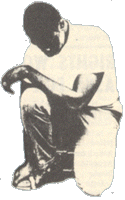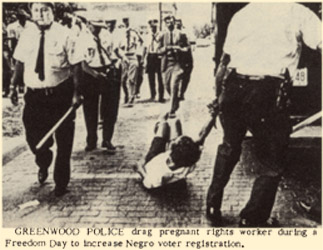 |
 |
 |
 |
 |
 |
|
To rally support from whites and blacks outside the movement, the sit-ins needed to create a distinct impression of moral superiority. One of the best ways to do this was to meet the harsh violence of the white man with pacifism. Some members expanded this philosophy to their daily lives, believing that just carrying a gun for self-defense was hostile. The philosophy of nonviolence hit shakier ground when SNCC began its period of community organization in the South, having to face continual threats of perhaps deadly violence from whites. On many occasions SNCC offices were sprayed with bullets or torched by local white men. In 1963 Bob Moses and Jimmy Travis, SNCC workers trying to encourage black voters to register, were shot at while driving near Greenwood, Mississippi. Travis was hit and nearly died. If there was no more public violence for SNCC to rise above, SNCC's message would be weakened. Thus, protesters were no longer beaten publicly. Instead they were attacked and beaten behind closed doors where newspaper reporters and television cameras could not reach. As southern whites intended, discrete violent oppression began to destroy the image of martyr that SNCC had carefully constructed through nonviolent protest. During this time, SNCC stopped sponsoring regular seminars on nonviolence and continued them only infrequently until 1964. Soon after, the Harlem Riots took place. It was the first urban race riot, and brought the topic of black-initiated violence into public debate. Such actions were no longer assumed to be counter productive. This event, and eventally the rise of black power, led to the fall of nonviolence in SNCC. |
 SNCC's
original statement of purpose established nonviolence as the driving
philosophy behind the organization. However, things were never
that simple. In the early days, during the period of the sit-in
movement, nonviolent action was strictly enforced, particularly
for public demonstrations, as it was key to the movement's success.
SNCC's
original statement of purpose established nonviolence as the driving
philosophy behind the organization. However, things were never
that simple. In the early days, during the period of the sit-in
movement, nonviolent action was strictly enforced, particularly
for public demonstrations, as it was key to the movement's success. A
majority of SNCC workers were beaten and thrown in prison at least
once during their work with the organization. As a result, once
strict guidelines of nonviolence were relaxed and members were
unofficially permitted to carry guns for self defense. However,
the principle was still adhered to publicly, as it remained an
effective means of protest. Eventually whites began to understand
the tactic, and nonviolence became less powerful. Whites began
to realize SNCC's peaceful responses to violent oppression were
key to gaining support for their cause.
A
majority of SNCC workers were beaten and thrown in prison at least
once during their work with the organization. As a result, once
strict guidelines of nonviolence were relaxed and members were
unofficially permitted to carry guns for self defense. However,
the principle was still adhered to publicly, as it remained an
effective means of protest. Eventually whites began to understand
the tactic, and nonviolence became less powerful. Whites began
to realize SNCC's peaceful responses to violent oppression were
key to gaining support for their cause.